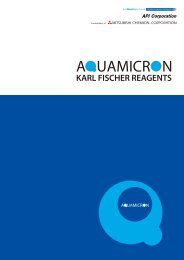Development of Karl Fischer Reagents
Development of Karl Fischer Reagents
Development of Karl Fischer Reagents
You also want an ePaper? Increase the reach of your titles
YUMPU automatically turns print PDFs into web optimized ePapers that Google loves.
[Characteristics]<br />
[Applications]<br />
Chapter I: Basic Knowledge<br />
a) The moisture content in gases can be captured completely, and there is<br />
minimal vaporization <strong>of</strong> the solvent even when large volumes <strong>of</strong> gas are<br />
passed through it.<br />
b) The reaction between water and the <strong>Karl</strong> <strong>Fischer</strong> reagent occurs rapidly.<br />
c) The end-point can be readily determined and measured over a short<br />
period <strong>of</strong> time.<br />
Inorganic gases (hydrogen, nitrogen, oxygen, argon, helium, etc.)<br />
hydrocarbons (ethylene, acetylene, propylene, propane, butane, etc.)<br />
Vaporization solvent for plastics, minerals, greases, lubricants, etc. Also<br />
excellent for use with inorganic salts, which dissolve readily in this product.<br />
Reference: Muroi, K., Ono, M., Sekiyu Gakkaishi [Journal <strong>of</strong> Japan<br />
Petroleum Society] 11 (No. 6), 440 (1968).<br />
K. Muroi, Bunseki Kagaku 20, 975 (1971).<br />
(2) Dehydrated Solvents used to Prevent Interference Reactions<br />
Aldehydes or ketones that include active carbonyls cause interference<br />
reactions by reacting with methanol to produce water (see Q8). To<br />
prevent such reactions and measure moisture content accurately, it is<br />
necessary to use a dehydrated solvent designed for use with ketones.<br />
The same dehydrated solvent can be used with lower carboxylic acid,<br />
which causes a similar reaction. Reactivity varies according to the<br />
specific substance and users should be aware that there are limitations<br />
on the size <strong>of</strong> the samples that can be measured.<br />
Principal ingredients <strong>of</strong> solvent<br />
Propylene carbonate<br />
Diethylene glycol monoethyl ether<br />
Chlor<strong>of</strong>orm<br />
Propylene carbonate<br />
Pyridine<br />
Ethylene glycol<br />
Pyridine<br />
Propylene glycol<br />
KTX(pyridine-free)<br />
CP<br />
PE<br />
PP<br />
Name Use Packaging<br />
Ketones<br />
Lower carboxylic acid<br />
Ketones<br />
Lower carboxylic acid<br />
Silicone oils<br />
Special-purpose<br />
paints and varnishes<br />
Aldehydes<br />
500ml bottles<br />
500ml bottles<br />
500ml bottles<br />
500ml bottles<br />
29




